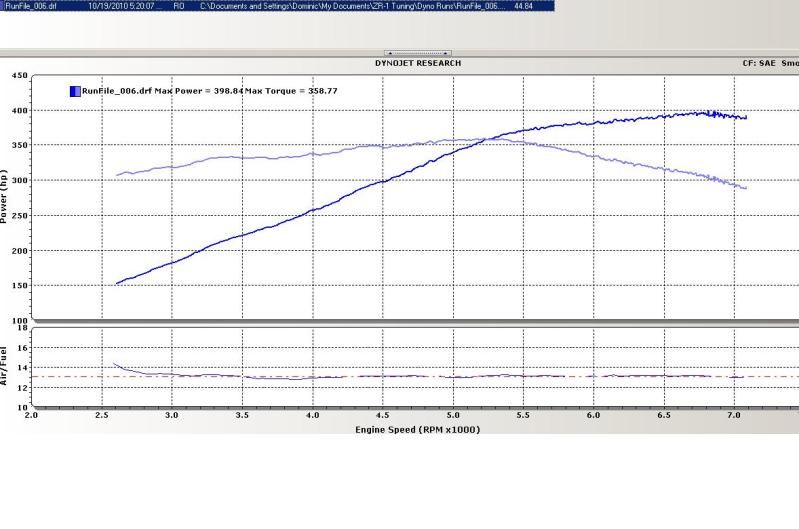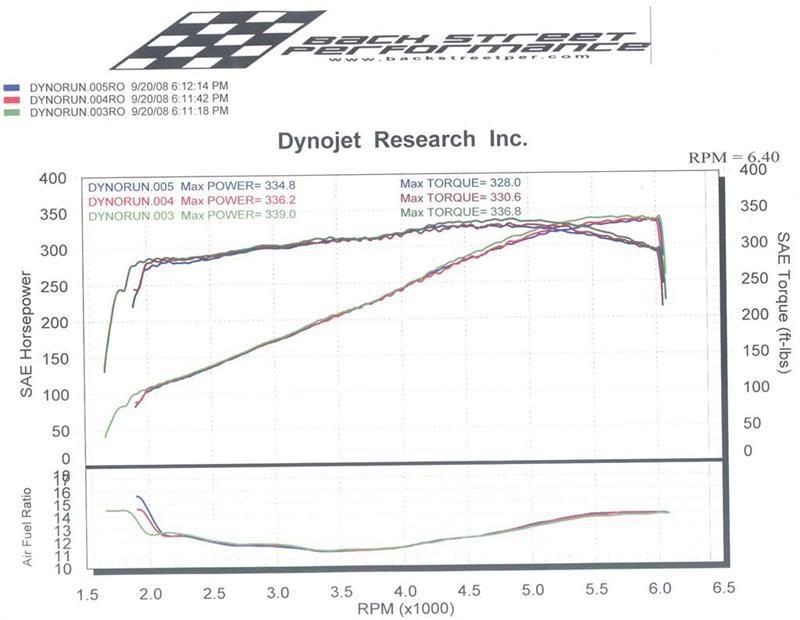|
|
#11 | ||
|
Join Date: Dec 2012
Location: NC
Posts: 1,783
|
Quote:
Quote:
What's the chance now Lee, that you can cut some 45' channels on that mill - even some short grooves - into the head port inlets, to break up that 'standing wave' (that I can well imagine that exists) ??? I just bet that would be 7 - 10 more HP on the dyno... And even if you had only taper-ported the IH's, from plenum juncture, to head, would you have then gotten 37 more HP? OR MORE??? I bet so. I sure wish some others 'in the know' would ring in on this........... Has anyone else done plenum + IH portwork ON OTHERWISE STOCK MOTOR, and done a dyno? Any links on LT5 portwork, with IN-DEPTH details? |
||
|
|

|
|
|
#12 | |
 Join Date: Nov 2007
Location: Squires (near Ava MO in the Mark Twain N'tl Forest) - Missouri
Posts: 6,466
|
Quote:
 (something new). I thought you were asking a question regarding optimizing the transition from 36mm to 33ish, and not a hp prediction (which I wouldn't have ventured to comment on). (something new). I thought you were asking a question regarding optimizing the transition from 36mm to 33ish, and not a hp prediction (which I wouldn't have ventured to comment on). Anyway, only 37 hp gain WITH a 63mm TB and ported air horn seems low. For example, this graph shows Dom's car when it was stock except for the plenum and IHs were at ≈ 36mm. I snap gauged the (GVD?) heads he had on it and they were tapered almost exactly as I described mine were. At the time, Dom's car is showing about 395 rwhp(!) - and you'd have to ask him, but I believe that was with the stock 58mm TB then too.  So, if you were to optimize your scenario (w/o port matching), it would be interesting to compare. And, IF(?) yours comes up short, well at least you know where to start looking for more hp, I recon! |
|
|
|

|
|
|
#13 |
 Join Date: Nov 2007
Location: Squires (near Ava MO in the Mark Twain N'tl Forest) - Missouri
Posts: 6,466
|
To visualize flow (gas or liquid) hold a table knife under a stream of water from a faucet with the blade vertical (edge on) to the stream. Then turn the blade 90º so the stream hits the flat side and observe the reaction. The water splatters in all directions, perpendicular (more or less) to the stream. Gas does the same thing, but imagine now the stream is contained in a tube. Suddenly, the tube diameter changes. That portion of the stream flowing along the tube wall suddenly is displaced by the wall of the smaller tube. The air splatters in the only direction it can, and that is toward the center of the tube causing the air to compress, and due to momentum, the pressure measured at the narrowing is higher than the pressure before or after the narrowing. Pressure plotted vertically on a graph comparing pressure to length, the plot would look like a wave that would peak at or near the point of restriction. The wave remains stationary (standing wave) as long as flow continues in the same direction, and it is this pressure wave that impedes flow - sort of like when traffic flowing in one direction in two lanes and suddenly one lane is closed off.
The nuances of porting vary, but the specifics are generally held 'close to the chest'. I know that guys like Marc and Pete and Bob G (me!) have considerable time and money invested in what they know, and that knowledge is a marketable thing that I wouldn't expect would be divulged freely. |
|
|

|
|
|
#14 |
 Join Date: Mar 2007
Location: Crystal Lake, IL
Posts: 7,180
|
Paul a 37rwhp gain on an untuned car is absolutely not low......this car also had stock exhaust manifolds.....392 at the rear wheel.
Dominics car was port matched well into the runner, with 63mmtb and well tuned. From Haibecks website: 5.Top end porting. About +35 hp ’90-’92. About 20 hp ’93-’95. *This would be tuned with port match and 63mm
__________________
LGAFF 90 #966-150K miles-sold 92 #234-sold 1987 Callaway TT #17 1991 ZR-1 #1359 Last edited by LGAFF; 03-24-2014 at 08:19 AM. |
|
|

|
|
|
#15 | |
 Join Date: Nov 2007
Location: Squires (near Ava MO in the Mark Twain N'tl Forest) - Missouri
Posts: 6,466
|
Quote:
You said: "Some people have asked about port matching the heads to the intake....obvious solution is the taper the IH runner, but if you plan on port matching in the future, you might go ahead and open it up to 36mm from the get go..... if so this is what a 36+MM IH look like when mated to a stock head...to me its not that bad...not optimal; but I am guessing you are still picking up over a tapered runner:" Forgive me, Lee, but guess I read this as more of a question than a statement. Mebby not? Anyway, sorry for the confusion. I posted Dominic's results as an example* of what can be accomplished (≈395 rwhp) with top end porting and a well port-matched head (read: min 4º taper his GVD heads had). (Below) was my bone stock dyno run, averaging 337 rwhp (cutoff early due to a lean condition developing - due to a couple weak injectors, as it later turned out.)  I've no idea what Dom's stock #s were, but using my stock #s and comparing it to his "ALL-IN" results, the net is a 395-337 = 58 rwhp increase WITH port matching and tune. But it is what it is (not impugning ya at all!). So if you got 37* hp w/o port matching the heads and little else (particulars of the test not withstanding) I guess the question is, how would it compare with everything sans port matching compare to Dom's 395 hp example with port matching? All but port matching being equal, I'm supposing the value of port matching the heads would be somewhere between your 37 and Dom's 58 hp net gain, me thinks.
Last edited by Paul Workman; 03-24-2014 at 12:49 PM. |
|
|
|

|
|
|
#16 |
 Join Date: Feb 2011
Location: San Marcos CA
Posts: 1,786
|
I ported mine before I had headers and I think it was only good for 20 rwhp or so and about the same torque as a stock car with a cat-back. This was all over 5000 rpm so really not the big seat-of-the-pants kick like you wish all mods had, but still, it seemed to run better on the freeway than it previously did. I did port down into the heads on the primary to smooth out the ridge and port mismatch.
I think Paul's experience with the porting gain was because he already had headers and supporting mods when he went with a full aggressive porting and secondary removal...So probably there was a nice big step that he could feel. now to finish this story, I finally got long tube headers (2" primaries) and a proper x-pipe on the cat-back and boy oh boy did that wake it up! Was it because the headers help the mid range torque (they do-and you feel it), or was it because the top end porting done the previous year was finally able to contribute to the big gain because the bottle neck in the exhaust was finally taken car of? Probably in my case the top end port helped the header mod to feel so significant. One might also mention that if you kind of do mods in incremental steps, you get used to the power and it isn't the same as spending all the money at once and getting a 100hp gain. I gave a ride in my car to a guy with a stocker and he said he thought it really pulled massively and wants to mod similarly. Probably time to get back to the dyno if I don't end up selling the car first. Last edited by mike100; 03-24-2014 at 11:59 AM. |
|
|

|
|
|
#17 |
 Join Date: Feb 2011
Location: San Marcos CA
Posts: 1,786
|
No reason to make the task difficult. Just mark the port circle with the gasket, test fit the IH, and grind it. All the time was spent masking it off, stuffing oil soaked towels in the port, vacuuming and making sure the valve was closed on the port being worked on (turned engine with tool on crankshaft).
 I didn't go the full 36MM, so I didn't have to taper 2" down. This hole took 10-15 minutes to do, it was the extra prep that takes the time. I did all 8 in about 5-6 hours. 
|
|
|

|
|
|
#18 | ||
|
Join Date: Dec 2012
Location: NC
Posts: 1,783
|
Paul - thanks, but what's baffling isn't what a standing wave could be. When I said I don't know flow dynamics, I was trying to be a little modest here...
What's baffling is that LeeG dyno'ed 37+ HP increase, with NO flow enhancement at the head, at the IH-to-head interface. You even said you thought possible that NO gain could be the scenario: Quote:
So, given that 'nasty eddies', or a 'standing wave' (call it what you want) DOES exist, where the IH is opened to 36mm, and the head inlet is NOT touched, but remains at 32.5mm, with only the factory bevel cut in, then even some furrows / vanes / channels cut into the head inlet, would CERTAINLY break the eddies (or standing wave), SUBSTANTIALLY, and boost HP 7 - 10, maybe 12HP +++, OVER WHAT HE DID GET... RIGHT??? Or even more efficient than furrows / vanes / channels, would be dimples - like the golf ball aerodyne that I referred to, which would enhance airflow lamination, vs. turbulence (eddies, standing waves, etc.). No one into fluid dynamics here? Anyone can just 'open up the holes' blindly, and hope for the best...    Quote:
Last edited by Schrade; 03-24-2014 at 08:59 PM. |
||
|
|

|
|
|
#19 |
 Join Date: Feb 2011
Location: San Marcos CA
Posts: 1,786
|
Nobody is blindly just hogging out ports. It has been proven out many times before and Paul's taper specification has been tried and proven on may applications and is a good rule-of-thumb.
the golf ball aerodynamic reference is valid- it is recommended to leave intake ports a tad rough and not polished. I think the reason that gains are possible even on such mis-matched ports is because these engines are way under ported and starving for air. certainly square edges are undesirable, but the LT5 defies convention- certainly compared to a 350 chevy. |
|
|

|
|
|
#20 |
|
Join Date: May 2007
Location: Chicagoland, IL
Posts: 9,683
|
Just to clarify, the 398# was with stock heads and cams not the ported GVD heads which went on when I upgraded the intake cams. When I did port the IHs and plenum, I also did a port match BUT only of the primary runner since the secondary was already ~ 36mm. I left the ridge also in the secondary runner and tapered the primaries about 2" below the deck. The secondary throttle shafts were also still in the heads.
The 398# was using a 63mm TB, full exhaust including MFlow resonator and muffs. Finally, at the time the camshafts were "as is" which we later found out were not timed optimally. So those were the conditions for the dyno run. |
|
|

|
 |
| Thread Tools | |
| Display Modes | |
|
|